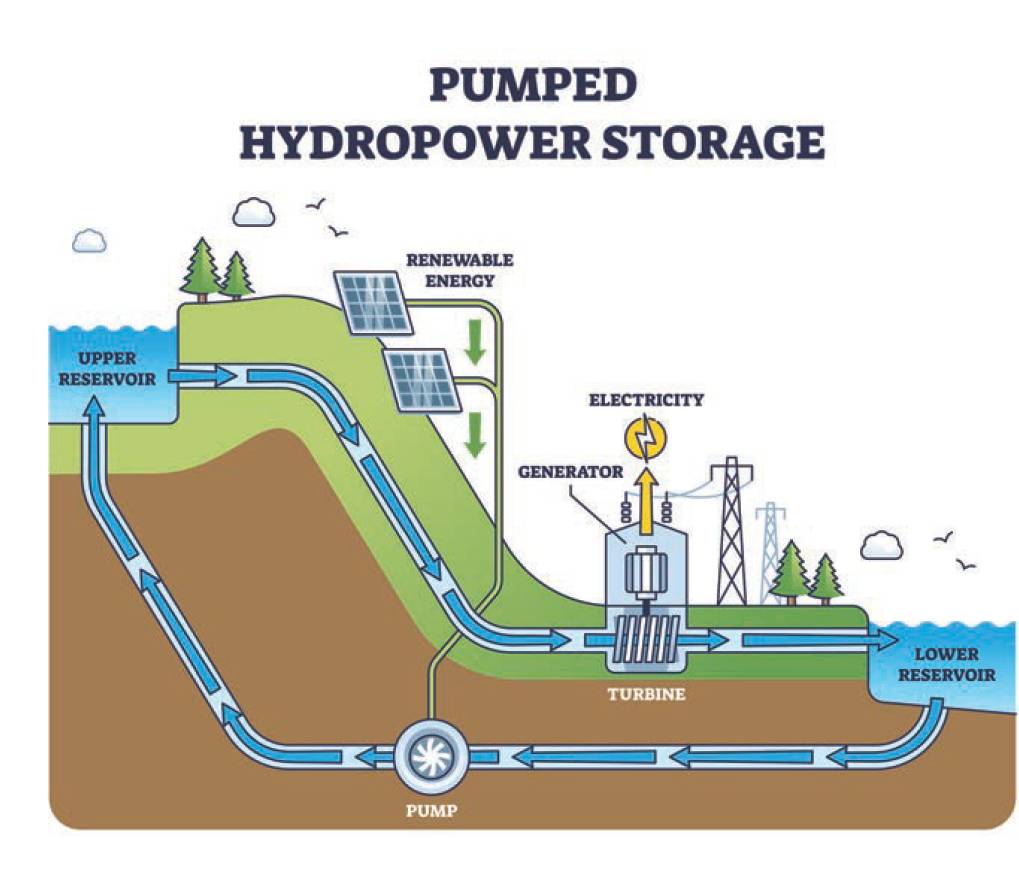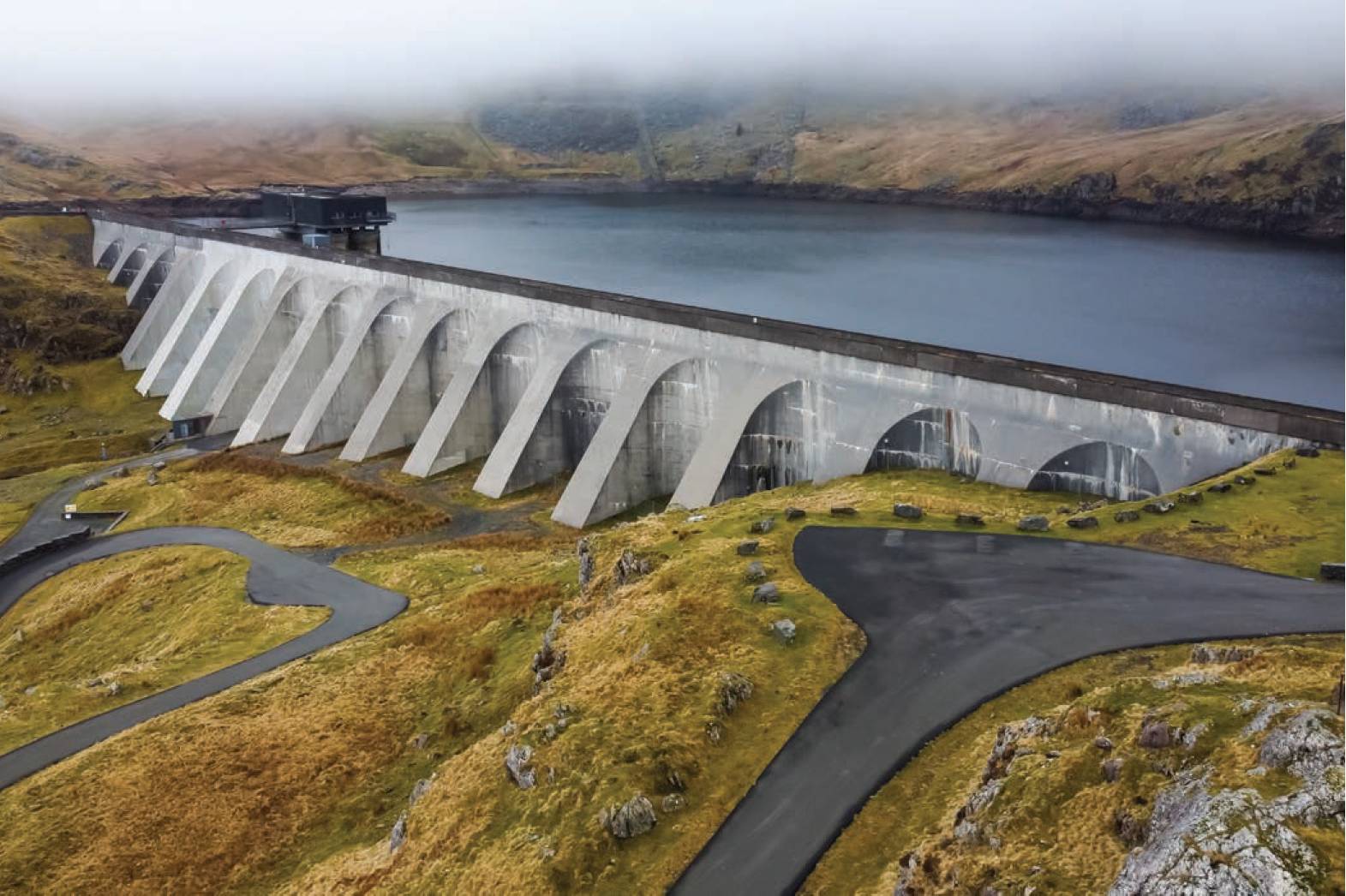
A REVOLUTION IN RENEWABLES
There is something magnificent and simple in generating power from flowing water. Dams and run-of-river hydro are the most intuitive, but the certainty of dynamic energy pricing means pumping water back up the hill when power is cheap also makes clear sense.
In the 1960s, when major infrastructure projects were easier to build, the UK commissioned two pumped storage hydropower (PSH) schemes: Ffestiniog and Cruachan, with two more in the following decades. However, the rise of cheap fossil fuels, their inherent convenience in terms of energy storage and a lack of regulatory support on capital costs and price stability means no new PSH has been built in over 40 years. The three-fold increase in renewables and a 30% drop in our gas storage in the last 10 years has caused a sharp focus on the availability and storage of energy. As if to demonstrate the problem, cold overcast and windless conditions dominated the British Isles on the December day the government chose to release its clean power report. On that day, 72% of energy generation came from gas.

One issue with the current plan to decarbonise the grid is that it relies on a herculean three-times ramp up of offshore wind and solar capacity over a five-year period, inferring a five-times uplift in construction rates versus the average over the last 15 years. Another issue is that, even with such a large fleet of wind turbines and solar farms, we will still rely on 35GW of unabated gas to power Britain in dunkelflaute conditions – the regular winter weather of no wind or sun.
Pumped storage hydropower is the best energy storage solution at scale, but it takes time to build and 2030 is an ambitious, round number. No one would deny it is sensible to retain gas as a continency, but a means grid balancing costs, known as constraint and curtailment charges, could rise to £12.7bn by 2030 if storage is not fully addressed.
If the projects are staggered rather than in competition with one another, they could sustain 3,000 jobs on site and in the supply chain over a 10 to 20year period.
Another option is lithium batteries, which are an important part of the energy storage solution. They can be placed anywhere around the country and can deliver in under a second. The challenge is each site is typically 50MW of capacity and only lasts two hours, while pumped storage projects like Balliemeanoch in Argyll and Bute can be 1.5GW and 45GWh giving 30 hours duration – a meaningful addition to the grid and sufficient to power over four million homes.
Luckily, there are 11 pumped storage projects in various stages of development with a cluster in the Great Glen – taking advantage of the vast waters of Loch Ness and adjacent high ground. Energy storage in Scotland is also justified by the proximity to offshore wind and the planned Eastern Green Link cables transmitting HVDC power between Scotland and sites in counties Durham, Yorkshire and Lincolnshire.
There are significant opportunities for engineers and contractors willing to get involved with these projects. A typical pumped storage scheme is around £2bn capital expenditure, involving 500m-wide, 80m-high reservoir dam walls and 2km of tunnels leading to church-sized turbine halls deep underground. If the projects are staggered rather than in competition with one another, they could sustain 3,000 jobs on site and in the supply chain over a 10 to 20-year period.

The pumped storage hydropower station in Ffestiniog, Wales, commissioned in 1963.
Announced in October 2024, the UK government’s Department for Energy Security and Net Zero has designed a new scheme to stimulate investment into long duration energy storage (LDES) technologies. The cap and floor mechanism aims to limit developers’ exposure to market risk and has been successfully used for over 10 years for UK interconnector investment. Top up payments are made to a developer if generated revenues are lower than a floor price to allow recovery of invested capital, while the cap will reflect equity returns for assets with a similar risk profile with excesses repaid to the regulator, Ofgem.
Overall, pumped storage developers have welcomed the scheme. It is clear that Ofgem has moved at pace, enacting on feedback to understand the scale, remoteness and legacy of these major energy assets. The scheme’s final design focuses on technologies that can last the 25year regime period at continuous rated power for a minimum of eight hours at 100MW. This is supportive of the majority of pumped storage projects and there is a chance smaller schemes could redesign or be permitted at a later window if their locational advantages are viewed as a priority.
The new UK PSH projects could add a combined 10GW and 200GWh to the UK grid, and whilst only a few might be eligible for this initial round of regulatory support, the increasing requirement for electricity generation and grid balancing out to 2050, will no doubt justify further pumped storage investment.
Pumped storage hydropower needs to be regarded very differently to wind and solar arrays or interconnectors, due to its scale and risk profile
Savings for the energy system are estimated to be £24bn by 2050 from 20GW of LDES and there are other renewable technologies including tidal range that can add meaningful capacity and baseload power to the UK grid.
The UK’s annual electricity demand currently stands at 320TWh but is forecast to double to between 550-680 TWh in 2050, depending how net zero is achieved. Electrifying transport, heating and heavy industry all drives this growth, and while a range of generation and demandside flexibility is needed, regulators and politicians must keep the intermittency of renewables and the imperative of long duration energy storage at the forefront of decisions.
Pumped storage hydropower needs to be regarded very differently to wind and solar arrays or interconnectors, due to its scale and risk profile, but also because of its lifespan. Turbine upgrades are expected every 40 years and dam infrastructure should last over 100 years – timeframes outside a government’s usual cost benefit analysis. Pumped storage is akin to investing in a house rather than a car. Major infrastructure also requires a collaborative mindset between contractors, community groups, regulators, local and national government. Contracts should enable cohesion not fault finding, and team leaders should convey a positive ethos and the national importance of the project.
To conclude with a hydroelectric success story, turn to the Hoover Dam. Its lead engineer, Frank Crowe, had a long career in building dams in the US and knew how to deal with different people at different levels. In being permitted the freedom to bring a loyal and trusted team with him, he was able to finish it in 1936, under budget and two years ahead of schedule. The British Hydropower Association hopes a new Frank Crowe can be found from the members of the Chartered Institution of Civil Engineering Surveyors to achieve this exciting series of UK projects into the 2030s.